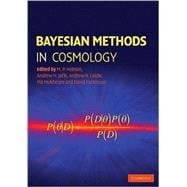
Note: Supplemental materials are not guaranteed with Rental or Used book purchases.
Purchase Benefits
What is included with this book?
| List of contributors | p. ix |
| Preface | p. xi |
| Methods | p. 1 |
| Foundations and algorithms | p. 3 |
| Rational inference | p. 3 |
| Foundations | p. 4 |
| Inference | p. 11 |
| Algorithms | p. 20 |
| Concluding remarks | p. 32 |
| Simple applications of Bayesian methods | p. 36 |
| Introduction | p. 36 |
| Essentials of modern cosmology | p. 37 |
| Theorists and pre-processed data | p. 41 |
| Experimentalists and raw measurements | p. 49 |
| Concluding remarks | p. 54 |
| Parameter estimation using Monte Carlo sampling | p. 57 |
| Why do sampling? | p. 57 |
| How do I get the samples? | p. 59 |
| Have I taken enough samples yet? | p. 69 |
| What do I do with the samples? | p. 70 |
| Conclusions | p. 77 |
| Model selection and multi-model inference | p. 79 |
| Introduction | p. 79 |
| Levels of Bayesian inference | p. 80 |
| The Bayesian framework | p. 82 |
| Computing the Bayesian evidence | p. 87 |
| Interpretational scales | p. 89 |
| Applications | p. 90 |
| Conclusions | p. 96 |
| Bayesian experimental design and model selection forecasting | p. 99 |
| Introduction | p. 99 |
| Predicting the effectiveness of future experiments | p. 100 |
| Experiment optimization for error reduction | p. 106 |
| Experiment optimization for model selection | p. 115 |
| Predicting the outcome of model selection | p. 120 |
| Summary | p. 124 |
| Signal separation in cosmology | p. 126 |
| Model of the data | p. 127 |
| The hidden, visible and data spaces | p. 128 |
| Parameterization of the hidden space | p. 129 |
| Choice of data space | p. 133 |
| Applying Bayes' theorem | p. 137 |
| Non-blind signal separation | p. 140 |
| (Semi-)blind signal separation | p. 151 |
| Applications | p. 165 |
| Bayesian source extraction | p. 167 |
| Traditional approaches | p. 168 |
| The Bayesian approach | p. 170 |
| Variable-source-number models | p. 175 |
| Fixed-source-number models | p. 178 |
| Single-source models | p. 178 |
| Conclusions | p. 191 |
| Flux measurement | p. 193 |
| Introduction | p. 193 |
| Photometric measurements | p. 193 |
| Classical flux estimation | p. 196 |
| The source population | p. 199 |
| Bayesian flux inference | p. 201 |
| The faintest sources | p. 204 |
| Practical flux measurement | p. 209 |
| Gravitational wave astronomy | p. 213 |
| A new spectrum | p. 213 |
| Gravitational wave data analysis | p. 214 |
| The Bayesian approach | p. 220 |
| Bayesian analysis of cosmic microwave background data | p. 229 |
| Introduction | p. 229 |
| The CMB as a hierarchical model | p. 231 |
| Polarization | p. 240 |
| Complications | p. 242 |
| Conclusions | p. 243 |
| Bayesian multilevel modelling of cosmological populations | p. 245 |
| Introduction | p. 245 |
| Galaxy distance indicators | p. 247 |
| Multilevel models | p. 252 |
| Future directions | p. 261 |
| A Bayesian approach to galaxy evolution studies | p. 265 |
| Discovery space | p. 265 |
| Average versus maximum likelihood | p. 266 |
| Priors and Malmquist/Eddington bias | p. 268 |
| Small samples | p. 270 |
| Measuring a width in the presence of a contaminating population | p. 272 |
| Fitting a trend in the presence of outliers | p. 275 |
| What is the number returned by tests such as x2, KS, etc.? | p. 280 |
| Summary | p. 281 |
| Photometric redshift estimation: methods and applications | p. 283 |
| Introduction | p. 283 |
| Template methods | p. 285 |
| Bayesian methods and non-colour priors | p. 286 |
| Training methods and neural networks | p. 287 |
| Errors on photo-z | p. 289 |
| Optimal filters | p. 290 |
| Comparison of photo-z codes | p. 290 |
| The role of spectroscopic datasets | p. 292 |
| Synergy with cosmological probes | p. 294 |
| Discussion | p. 296 |
| Index | p. 299 |
| Table of Contents provided by Ingram. All Rights Reserved. |
The New copy of this book will include any supplemental materials advertised. Please check the title of the book to determine if it should include any access cards, study guides, lab manuals, CDs, etc.
The Used, Rental and eBook copies of this book are not guaranteed to include any supplemental materials. Typically, only the book itself is included. This is true even if the title states it includes any access cards, study guides, lab manuals, CDs, etc.